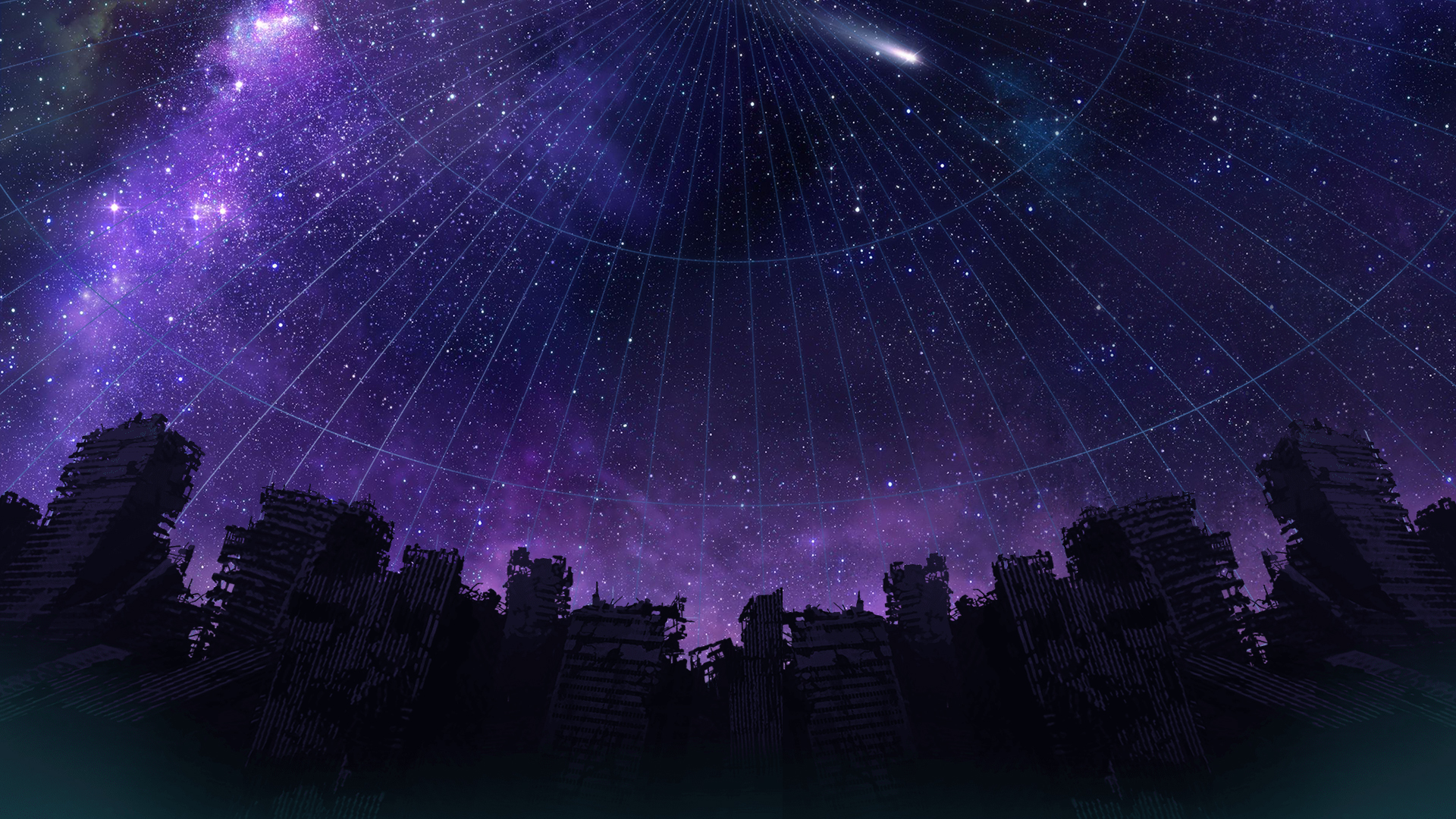The final thing I want to discuss is the use of music: For those of you that aren’t aware, I did an analysis of every track in the planetarian soundtrack in the Planetarian - General Discussion page, and how each track is used to represent certain themes and concepts throughout the novel. Now, I did this before I actually listened to the Hoshi No Hito audio drama (I had seen the anime adaptation before though), and I’m actually really surprised how many things actually followed through to this (and other things that didn’t). I’m going to go through each of the main things that stuck out to me, in the order they’re presented in the audio drama:
The general ‘Hoshi Meguri no Uta’ motif: In planetarian, the melody line within this piece is used within multiple tracks under a similar name (e.g. Hoshi Meguri no Uta (metronome)). It is easy to associate this motif with Yumemi due to how it’s generally used within the original novel, but I also put across the idea that this is also potentially the Junker’s theme. This held up really well when listening to this drama, because this motif is generally only used when the Junker is around. One could argue that most of the tracks in planetarian use this motif, and the Junker is shown in most of the story, so it could just be coincidence, in which I say yes you are completely correct, because there are very specific cases where the tracks are and aren’t used which stood out to me. The exception of this idea of the motif being related to the Junker is during the beginning of ‘Visitor’, after the Junker is rescued from the snow. The ‘Honky Tonk’ track plays and the only reason I can think of why this theme is used there is because it’s the only track that conveys any sense of quirkiness, which makes sense given the situation. However, in track 5 (Treasure), ‘Ame to Robot’ is playing when the children are going to get their treasure. This is one of the only times when the Junker doesn’t appear in the drama – and this track plays instead of any of the ‘Hoshi Meguri no Uta’ pieces, which is significant of the Junkers lack of presence. So basically, that argument can go either way, but I personally think this concept still holds.
Hoshi Meguri no Uta (Metronome): This is the track that is used for the most part of the drama. In my original post I stated how it represents the Junker’s awareness of the passing of time, and how he doesn’t much time left to do what he wants. The same concept applies here - he knows he’s dying, it’s one of the reasons he’s so happy to have found some disciples to carry on Yumemi’s message, so in many ways, this track is used almost identically to how it’s used in the original VN.
Hoshi Meguri no Uta (Winter’s tale): Contrary to what many might expect, this piece is used during the projection scene, where the Junker shows the three children the stars. Given the original novel, you would probably expect Gentle Jena to be playing at this moment, and while yes it would have been perfectly appropriate, this piece works better in my opinion. In my original analysis I suggested that this piece is used to represent the moment when the Junker starts to become the stargazer, and it has a similar use in this. As soon as the Junker shows the three children the stars, they want to become stargazers as well, so similarly to how this piece is used in the VN to show Yumemi making the Junker believe in the stars, and making him want to dedicate his life to showing people the stars, Hoshi No Hito uses it to show the Junker making the children believe in the stars, and making them want to dedicate their lives to showing people the stars.
Mattaki Hito/Perfect Human: In my original analysis I proposed the idea that the small flourishes in sound represented sparks of electricity leaving Yumemi’s body. Since this is used during the Junker’s death, that doesn’t exactly follow. However, I did say this piece acts as a requiem mass, which still holds given the context it’s used in. It gives the listener a reason to mourn over the loss of the Junker. Also the title still has some significance. If we consider the Junker through his life after the events of planetarian, he tried to spend his life bringing hope to others – he acts as an ideal figure. Even when he’s dying, he never once shows an ounce of negativity to anyone at the village – similarly to Yumemi, so even though he may not be a perfect human, because that’s impossible, he is trying to live up the Yumemi, who can be perceived as a perfect human due to her nature throughout her life.
Hoshi No Sekai: I already discussed how this piece is used to represent concepts of hope through instrumentation among other things, and that part does still hold. This piece plays when the children close their eyes and realise that they can still see the stars. To me, this piece is now Yumemi’s theme, as it represents when someone has fully encompassed Yumemi’s belief in the stars - the children do not need a projector to see the stars since the stars are engraved into their hearts. In many ways this can also be considered Yumemi’s theme in the original VN as well, especially if you consider planetarians religious connotations and the origins of the melody of this piece, but that’s something I forgot to mention during my original analysis. So since this is now considered Yumemi’s theme, this piece gives a suggestion that Yumemi is now a part of the three children, which is because they now truly believe in what Yumemi believed in – she has offered them faith and they have accepted it. I also want to mention how this is the one time that this piece is used, and the ‘Why don’t you come to the planetarium speech’ isn’t said – well except it kind of is, just not in a conventional way. During this scene the Junker states ‘The stars will always be shining in the path in front of you. Because the stars you see at the planetarium is something you can never forget’. This is similar to Yumemi’s line ‘The beautiful twinkling of eternity, that will never fade, no matter when.’ – the concept presented by both lines is incredibly similar, so even though it may not be the exact same line, what’s trying to be conveyed is pretty much the same – the idea that the stars will always be there, and will always be beautiful.
Gentle Jena: This is played when the Junker goes and see’s Yumemi in heaven, which causes the average human being to start crying. I mentioned how in the VN, this piece essentially acts like planetarian’s hymn, and this once again extends into this story. This piece first starts playing when the Junker is asking Yumemi if there is only one heaven, and whether he can be forgiven. This is essentially the Junker praying to Yumemi, so the use of planetarian’s hymn makes sense, as it’s trying to convey is strong belief and faith in Yumemi during this. While in heaven, there are many people in the planetarium. The Junker describes them all as stargazers, and they’re about to witness Yumemi’s projection. I mentioned in one of my other posts how Yumemi’s projections act very similarly to a religious ceremony, and it only naturally follows that in many religious ceremonies, people sing hymns to express belief and worship. So if everyone in the planetarium is a stargazer (which can be considered as someone who follows Yumemi’s ‘religion’) and are there to watch Yumemi’s projection, that it’s natural that a hymn would be played, so that’s why Gentle Jena is used.
Itsukushimi Fukaki/Deep Affection: This is used at the very end of the drama, when the children are discussing the Junker’s treasure, Yumemi’s memory card, and then you hear Yumemi giving her ‘Why don’t you come to the planetarium’ speech. Once again, this piece represents how in death there is hope – even with the stargazer gone, the children still retain all his beliefs despite his death, and this memory card is proof of that. The ‘Why don’t you come to the planetarium’ speech is once again said, and it is proof that despite how there is no-one left in the world who knows about Yumemi, she still lives in the thoughts of others.
Gentle Jena Extended: I was proud of this. I had no clue that it was used at the very end of the audio drama, but the concepts I presented in my original analysis were on point and extremely accurate in my opinion, despite its lack of use in the VN. This piece is used at the end of the CD – there’s nothing happening except this music. In my original analysis I talked about how this piece acts as an epilogue to the original VN, and how it expresses the idea of the Junker telling people about the stars and how the multiple parts of this piece represent more people believing in the stars. This view held up really well as it still holds for Hoshi No Hito, except instead of the Junker making more people become stargazers, it’s the children. One thing I found really interesting when comparing this to other things in the world of planetarian was that in the VN, only one person was made into a stargazer (the Junker), while in this it was three (the children). To me, this symbolises growth in belief, and how with more and more generations, more people will become to believe about the stars and become stargazers. Using this song at the end represents this, and only emphasises the points that I made in my original post. Plus, if you consider how the theme of passing knowledge and faith from one generation to another is really prominent in this, it only makes sense that this track would help to convey that. I also made a point about how if you actually listen to this track, you become a part of what it represents, and that still holds here, just in a slightly different context. In my original post I argued about how if you looked up the soundtrack, you are part of a collective group of people who believe in the themes of planetarian – and the same argument holds here. If you liked planetarian enough to look up the side stories, you must have liked it a lot, in which the same argument holds, especially when you consider how you have to wait until the very end, after ‘Hoshi Meguri no Uta’ to here this. It’s kind of like waiting for an after credits scene in a film – you’ve got to like it enough to wait until the very end, even if you think it’s over. To me, this is an incredibly fitting way to end the Junker’s story as it shows how had an effect on the world, and how their beliefs will be forever passed on, both in the world of planetarian and in our world.
So that covers many of the significant tracks, but I should also note that there is a piece used in Hoshi No Hito which isn’t in the official soundtrack. During track 6 (Goddess) there’s a piece that plays when Ezula tells the children that the stargazer is no longer needed in this world, and they reject that concept. This is the only time this piece is used in the audio drama. This could have just been used as filler as since there isn’t a piece with a similar feel in the rest of the soundtrack, but part of me wonders if this is supposed to be the theme of the children. It’s impossible to tell since this piece comes up only once, but it could represent how each generation has something new to bring to the world, as represented by an all new piece of music.
So the soundtrack emphasises this idea of passing knowledge and faith from one generation to another, because most of the tracks are used in a similar context as the original VN, so it shows how events are repeating, but at the same time, it also shows how the world is slowly changing, and becoming something better.




